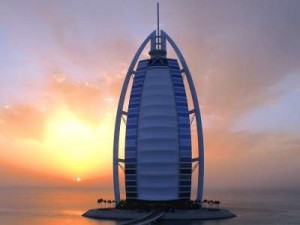United Arab Emirates (UAE)

• Full name: United Arab Emirates
• Population: 4.5 million (UN, 2008)
• Capital: Abu Dhabi
• Largest city: Dubai
• Area: 77,700 sq km (30,000 sq miles)
• Major language: Arabic
• Major religion: Islam
• Life expectancy: 77 years (men), 81 years (women) (UN)
• Monetary unit: 1 Dirham = 100 fils
• Main exports: Oil, gas
• GNI per capita: US $23,770 (World Bank, 2006)
• Internet domain: .ae
• International dialling code: +971
• Education budget:
• Healthcare Budget:
• Hospital Beds:
• Medical devices/furniture imports:
• Regulatory Environment:
• Product Registration:

GDP (purchasing power parity):
$184.3 billion (2008 est.)
country comparison to the world: 56
$171.6 billion (2007 est.)
$159.3 billion (2006 est.)
note: data are in 2008 US dollars
GDP (official exchange rate):
$260.1 billion (2008 est.)
GDP – real growth rate:
7.4% (2008 est.)
country comparison to the world: 27
7.7% (2007 est.)
9.4% (2006 est.)
GDP – per capita (PPP):
$39,900 (2008 est.)
country comparison to the world: 21
$38,600 (2007 est.)
$37,400 (2006 est.)
GDP – composition by sector:
agriculture: 1.5%
industry: 62.7%
services: 35.7% (2008 est.)
Labor force:
3.266 million
country comparison to the world: 97
note: expatriates account for about 85% of the work force (2008 est.)
Labor force – by occupation:
agriculture: 7%
industry: 15%
services: 78% (2000 est.)
Unemployment rate:
2.4% (2001)
country comparison to the world: 25
Population below poverty line:
19.5% (2003)
Household income or consumption by percentage share:
lowest 10%: NA%
highest 10%: NA%
Investment (gross fixed):
22.8% of GDP (2008 est.)
country comparison to the world: 71
Budget:
revenues: $78.74 billion
expenditures: $48.31 billion (2008 est.)
Public debt:
42.3% of GDP (2008 est.)
country comparison to the world: 49
Stock of domestic credit:
$NA (31 December 2008)
country comparison to the world: 36
$155.4 billion (31 December 2007)
Market value of publicly traded shares:
$224.7 billion (31 December 2007)
country comparison to the world: 34
Agriculture – products:
dates, vegetables, watermelons; poultry, eggs, dairy products; fish
Industries:
petroleum and petrochemicals; fishing, aluminum, cement, fertilizers, commercial ship repair, construction materials, some boat building, handicrafts, textiles
Industrial production growth rate:
6.7% (2008 est.)
country comparison to the world: 32
Electricity – production:
62.76 billion kWh (2006 est.)
country comparison to the world: 40
Electricity – consumption:
57.88 billion kWh (2006 est.)
country comparison to the world: 40
Oil – production:
2.948 million bbl/day (2007 est.)
country comparison to the world: 8
Oil – consumption:
381,000 bbl/day (2006 est.)
country comparison to the world: 33
Oil – exports:
2.703 million bbl/day (2005 est.)
country comparison to the world: 4
Oil – imports:
232,300 bbl/day (2005)
country comparison to the world: 42
Oil – proved reserves:
97.8 billion bbl (1 January 2008 est.)
country comparison to the world: 6
Natural gas – production:
48.79 billion cu m (2006 est.)
country comparison to the world: 18
Natural gas – consumption:
43.11 billion cu m (2006 est.)
country comparison to the world: 17
Natural gas – exports:
6.848 billion cu m (2005 est.)
country comparison to the world: 24
Natural gas – imports:
1.343 billion cu m (2005)
country comparison to the world: 48
Natural gas – proved reserves:
6.071 trillion cu m (1 January 2008 est.)
country comparison to the world: 5
Current account balance:
$34.3 billion (2008 est.)
country comparison to the world: 15
$25.84 billion (2007 est.)
Exports:
$210.5 billion (2008 est.)
country comparison to the world: 21
$170.4 billion (2007 est.)
Exports – commodities:
crude oil 45%, natural gas, reexports, dried fish, dates
Exports – partners:
Japan 25.5%, South Korea 8.6%, Thailand 5.8%, India 4.8% (2008)
Imports:
$145.8 billion (2008 est.)
country comparison to the world: 29
$116.6 billion (2007 est.)
Imports – commodities:
machinery and transport equipment, chemicals, food
Imports – partners:
China 13.5%, India 9.8%, US 9.2%, Germany 6.8%, Japan 6.4%, Turkey 4.7%, Italy 4.5% (2008)
Reserves of foreign exchange and gold:
$31.69 billion (31 December 2008 est.)
country comparison to the world: 40
$77.24 billion (31 December 2007 est.)
Debt – external:
$126.9 billion (31 December 2008 est.)
country comparison to the world: 31
Stock of direct foreign investment – at home:
$62.69 billion (31 December 2008 est.)
country comparison to the world: 47
Stock of direct foreign investment – abroad:
$28.95 billion (31 December 2008 est.)
country comparison to the world: 35
Exchange rates:
Emirati dirhams (AED) per US dollar – 3.6725 (2008 est.),